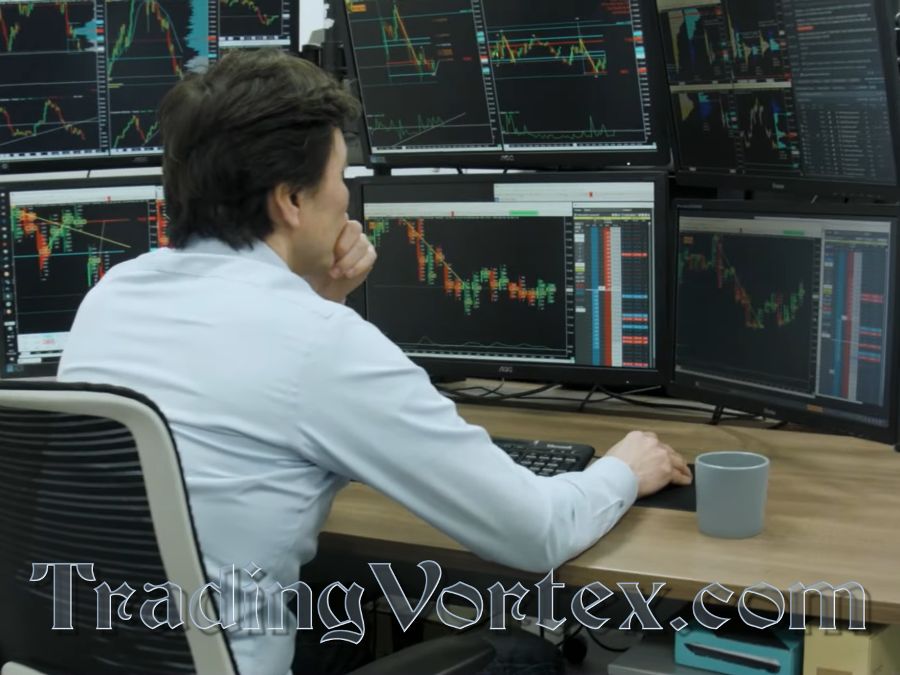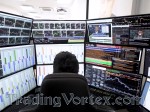Table Of Contents:
- The Basics of Volatility Trading:
Benefits of Engaging in Volatility Trading:
Getting Started with Volatility Trading:
Tools and Techniques for Analyzing Market Fluctuations:
Common Strategies in Volatility Trading:
Managing Risk in Volatility Trading:
Market Fluctuations Case Studies:
Psychology and Discipline in Volatility Trading:
Advanced Volatility Trading Strategies:
The Future of Volatility Trading:
Conclusion: “Profiting from Market Volatility: Your Path to Success!”
The Basics of Volatility Trading:
Volatility trading is a specialized approach to financial markets that centers on capitalizing on price fluctuations. This section will provide a fundamental understanding of volatility trading, including an exploration of market fluctuations and their underlying causes, as well as key principles that underpin successful volatility trading.
Exploring Market Fluctuations and Their Causes:
- Market Sentiment: Market sentiment plays a significant role in causing price fluctuations. Positive news can lead to bullish sentiment and price increases, while negative news can induce bearish sentiment and price declines. Traders need to gauge and react to these shifts in sentiment.
- Economic Events: Economic data releases, such as GDP reports, employment numbers, and central bank decisions, can trigger significant market movements. Traders often analyze economic calendars to anticipate and respond to these events.
- Geopolitical Events: Events like elections, conflicts, or policy changes in major economies can lead to heightened volatility. Geopolitical stability or turmoil can have a profound impact on market sentiment.
- Earnings Reports: For stock traders, corporate earnings reports are key drivers of price volatility. Positive earnings surprises can boost stock prices, while disappointing results can lead to sell-offs.
- Technical Factors: Technical analysis tools, such as chart patterns, support and resistance levels, and trend indicators, are used to identify potential price turning points. Traders often combine technical analysis with other factors to make informed decisions.
Key Principles of Volatility Trading:
Successful volatility trading relies on a set of key principles that guide traders in navigating the dynamic landscape of market fluctuations:
- Risk Management: Managing risk is paramount in volatility trading. Traders use various risk management techniques, including setting stop-loss orders, diversifying their portfolios, and sizing their positions appropriately to protect their capital.
- Understanding Volatility: Volatility is not just a measure of risk; it is also an opportunity for profit. Traders should embrace volatility and adapt their strategies to capitalize on it.
- Adaptability: Markets are constantly evolving, and what works in one environment may not work in another. Volatility traders need to be adaptable and willing to adjust their strategies as market conditions change.
- Continuous Learning: Volatility trading requires ongoing education and research. Staying informed about market developments, economic events, and new trading techniques is essential for success.
- Psychological Discipline: Emotions can be a trader's worst enemy. Developing emotional discipline, such as patience and the ability to stick to a trading plan, is critical for avoiding impulsive decisions.
In the following sections of this article, we will delve deeper into the strategies, tools, and techniques that leverage these principles to profit from market fluctuations. Whether you are a novice trader or an experienced investor, mastering the basics of volatility trading is a crucial step toward achieving your financial goals.
Benefits of Engaging in Volatility Trading:
Volatility trading offers a unique and potentially rewarding approach to financial markets. In this section, we will explore the benefits of engaging in volatility trading, highlighting the opportunities and advantages it presents, as well as the crucial role of risk management in navigating a volatile market environment.
Profiting from Market Volatility: Opportunities and Advantages.
- Diverse Profit Opportunities: Volatility trading provides traders with an array of strategies to profit from different market conditions. Whether markets are trending strongly or moving within a range, there are strategies tailored to exploit these conditions.
- Enhanced Returns: Volatility can be a source of significant price movements, which means the potential for higher returns compared to more stable market conditions. For traders adept at managing risk, this increased potential for profit is an attractive proposition.
- Hedging Portfolio Risk: Volatility trading can serve as an effective hedging tool. Traders can use volatility products to offset risks in their investment portfolios. "For example, during periods of heightened market uncertainty, volatility trades can act as a form of insurance, mitigating potential losses".
- Diversification: By engaging in volatility trading alongside traditional asset classes, investors can achieve greater portfolio diversification. This diversification can help spread risk and reduce the correlation of investments.
- Accessibility: With the advent of exchange-traded funds (ETFs) and derivatives, volatility trading is more accessible to retail investors than ever before. It's no longer confined to institutional traders, making it a viable option for a broader range of market participants.
Risk Management in a Volatile Market Environment:
- Defined Risk: Volatility trading often involves structured strategies with well-defined risk parameters. Traders can implement stop-loss orders and position sizing to control potential losses, enhancing risk management.
- Flexibility in Risk Exposure: Traders can adapt their risk exposure to match their risk tolerance and market outlook. They can choose from strategies that involve limited risk or those with potentially higher risk and reward profiles, depending on their comfort level.
- Portfolio Balancing: Incorporating volatility trading strategies into an investment portfolio can serve as a counterbalance to other asset classes. When equities or bonds are performing poorly due to market volatility, volatility trading can help stabilize overall portfolio returns.
- Learning and Skill Development: Engaging in volatility trading allows traders to develop valuable skills in risk assessment, market analysis, and decision-making. This skill-building can have applications beyond just volatility trading and contribute to overall financial acumen.
As we continue to explore the intricacies of volatility trading in the upcoming sections, it becomes evident that the benefits extend beyond merely profiting from market fluctuations. When approached with discipline and a sound strategy, volatility trading can be a valuable tool in the arsenal of investors and traders seeking to thrive in the dynamic world of finance.
Getting Started with Volatility Trading:
Entering the world of volatility trading requires a well-thought-out plan and a solid understanding of the fundamental principles. In this section, we will guide you through the initial steps of getting started with volatility trading, focusing on selecting suitable assets for this unique trading style and exploring strategies for making your entry into the volatility trading arena a successful one.
Selecting Suitable Assets for Volatility Trading:
- Options Contracts: Options are popular instruments in volatility trading. They allow traders to bet on the future price volatility of an underlying asset. You can choose from call options (betting on rising volatility) or put options (betting on falling volatility) based on your market outlook.
- Volatility Exchange-Traded Funds (ETFs): ETFs designed to track market volatility, such as the VIX ETF, offer a straightforward way to gain exposure to volatility fluctuations. These instruments derive their value from volatility futures contracts.
- Currency Pairs: In the foreign exchange (Forex) market, currency pairs like EUR/USD, GBP/JPY, and others can exhibit significant volatility, providing trading opportunities for Forex enthusiasts.
- Commodities: Certain commodities, such as gold and oil, are known for their price volatility. Traders can use commodity futures or options to capitalize on fluctuations in these markets.
- Stocks with High Beta: Beta measures a stock's sensitivity to market movements. Stocks with a high beta tend to be more volatile and can be attractive to volatility traders looking for individual equity opportunities.
Strategies for Entering the Volatility Trading Arena:
- Educate Yourself: Begin your journey by building a strong foundation of knowledge. Understand the concepts of implied and historical volatility, how volatility is measured, and the factors that influence it.
- Paper Trading: Before risking real capital, consider practicing with a paper trading account. This allows you to experiment with volatility trading strategies without financial risk.
- Choose Your Strategy: There are various volatility trading strategies, such as straddles, strangles, iron condors, and butterfly spreads. Each has its own risk-reward profile, so select a strategy that aligns with your risk tolerance and market outlook.
- Risk Management: Establish a risk management plan that includes setting stop-loss orders, defining position sizes, and diversifying your trades. Risk management is crucial in managing the inherent uncertainties of volatility trading.
- Stay Informed: Keep a close eye on market news, economic events, and factors that can impact volatility. Develop a trading routine that includes market analysis and research.
- Monitor and Adapt: Volatility trading is not a static endeavor. Markets evolve, and strategies that worked in the past may not be effective in the future. Continuously monitor your trades and adapt to changing market conditions.
By selecting suitable assets and following a well-structured approach to volatility trading, you can embark on this exciting journey with confidence. Remember that success in volatility trading often requires discipline, ongoing education, and the ability to adapt to the dynamic nature of financial markets. As you gain experience, you'll find that profiting from market fluctuations becomes a rewarding endeavor.
Tools and Techniques for Analyzing Market Fluctuations:
Analyzing market fluctuations is a critical aspect of successful volatility trading. In this section, we will explore the tools and techniques used by traders to gain insights into market dynamics, make informed decisions, and effectively navigate the volatile terrain. We'll delve into two primary approaches: technical analysis and fundamental analysis, each offering valuable insights for volatility traders.
Utilizing Technical Analysis for Market Volatility:
Technical analysis involves studying historical price and volume data to identify patterns, trends, and potential price reversals. In the context of volatility trading, technical analysis can be a powerful tool for making informed decisions:
- Candlestick Patterns: Traders use candlestick patterns to identify potential trend reversals or continuations. Patterns like doji, engulfing, and harami can signal changes in market sentiment.
- Support and Resistance Levels: Identifying key support and resistance levels helps traders pinpoint potential entry and exit points. In volatile markets, these levels can be particularly influential.
- Volatility Indicators: Various technical indicators, such as Bollinger Bands, Average True Range (ATR), and the Relative Strength Index (RSI), can provide insights into market volatility. Traders can use these indicators to gauge the intensity of price fluctuations.
- Moving Averages: Moving averages help smooth price data and identify trends. Traders often use moving average crossovers and divergence from moving averages as signals for potential trades.
- Fibonacci Retracement Levels: Fibonacci retracement levels are used to identify potential support and resistance areas based on the Fibonacci sequence. Traders look for price reactions at these levels.
- Volatility Breakouts: Traders seek out price breakouts from consolidation patterns, such as triangles or rectangles, as they can signal potential explosive moves in volatility.
Fundamental Analysis and Its Role in Volatility Trading:
Fundamental analysis involves examining the economic, financial, and geopolitical factors that can influence market prices. While it is often associated with longer-term investing, it plays a role in volatility trading as well:
- Economic Data Releases: Traders keep a close eye on economic indicators such as GDP growth, inflation rates, and employment figures. Positive or negative surprises in these data points can trigger market volatility.
- Corporate Earnings: In equity markets, earnings reports are crucial. Traders analyze company earnings, revenue, and guidance to gauge market reactions and potential volatility.
- Central Bank Policies: Central banks' decisions regarding interest rates and monetary policy can have a profound impact on currency and bond markets. Traders anticipate and react to central bank announcements.
- Geopolitical Events: Developments in global politics, such as elections, trade disputes, and conflicts, can lead to heightened market volatility. Traders consider the geopolitical landscape when assessing market conditions.
- Market Sentiment: Understanding market sentiment, which can be influenced by news, social media, and institutional flows, helps traders anticipate short-term price movements.
By combining technical analysis and fundamental analysis, traders can gain a holistic view of market fluctuations. These tools and techniques empower volatility traders to make informed decisions and adapt their strategies to capitalize on the ever-changing dynamics of the financial markets. In the following sections, we will explore specific volatility trading strategies that leverage these analytical approaches to maximize profit potential.
Common Strategies in Volatility Trading:
Volatility trading offers a wide array of strategies designed to harness the fluctuations in market prices. In this section, we will delve into two common and effective approaches to volatility trading: "options trading" and the use of "volatility exchange-traded funds (ETFs)". These strategies empower traders to capitalize on market volatility while managing risk effectively.
Options Trading: Leveraging Volatility for Profit.
Options trading is a versatile and widely used strategy in volatility trading. It allows traders to take positions based on their outlook for future volatility. Here are some key aspects of options trading in the context of volatility:
- Call and Put Options: Traders can use call options to bet on rising volatility and put options to bet on falling volatility. Calls give the right to buy an asset at a specified price (strike price), while puts give the right to sell an asset at a specified price.
- Straddle and Strangle Strategies: These strategies involve buying both call and put options with the same strike price (straddle) or different strike prices (strangle). They are used when traders anticipate a significant price move but are uncertain about the direction.
- Iron Condor and Butterfly Spreads: These are more complex options strategies that involve multiple legs of options positions. They can be used to profit from a range-bound market with limited price movement.
- Implied Volatility: Options prices are influenced by implied volatility, which represents the market's expectations for future price fluctuations. Traders often compare implied volatility to historical volatility to identify trading opportunities.
- Options Greeks: Understanding options Greeks, such as delta, gamma, and vega, helps traders assess how changes in volatility will affect their options positions.
- Risk Management: Options trading carries inherent risks, including the potential loss of the premium paid for the options. Risk management, including setting stop-loss orders and position sizing, is crucial.
Volatility ETFs and Their Applications:
Volatility ETFs offer a straightforward way for traders and investors to gain exposure to volatility fluctuations. These ETFs derive their value from volatility futures contracts, making them accessible to a broader range of market participants. Here's how volatility ETFs are commonly used:
- VIX ETFs: Exchange-traded products such as the VIX ETF (VXX) and others track the CBOE Volatility Index (VIX), often referred to as the "fear gauge." These ETFs provide a way to speculate on changes in market volatility.
- Inverse and Leveraged Volatility ETFs: Inverse volatility ETFs (e.g., XIV) allow traders to profit from declining market volatility, effectively taking short positions on volatility. Leveraged volatility ETFs (e.g., UVXY) amplify the returns (and risks) associated with volatility.
- Hedging Portfolios: Investors use volatility ETFs as a form of portfolio insurance during periods of market turbulence. When stocks or other assets in their portfolios decline, volatility ETFs can offset some of the losses.
- Pair Trading: Some traders employ a strategy known as pair trading, where they simultaneously hold long and short positions in different volatility ETFs to capitalize on relative changes in volatility.
- Tactical Allocation: Asset managers and traders use volatility ETFs for tactical asset allocation, adjusting their exposure to market volatility based on their short-term market outlook.
By incorporating options trading and volatility ETFs into their arsenal of strategies, traders can take advantage of different facets of market volatility. These approaches provide flexibility, enabling traders to adapt to various market conditions and profit from fluctuations in volatility, whether they expect it to rise or fall. In the following sections, we will further explore risk management and real-world case studies to illustrate the application of these strategies.
Managing Risk in Volatility Trading:
Effectively managing risk is a cornerstone of success in volatility trading. The inherent unpredictability of market fluctuations demands a disciplined approach to safeguard your capital and enhance your chances of profiting. In this section, we will explore risk management strategies tailored to the unique challenges of volatility trading.
Setting Stop-Loss Orders and Risk Mitigation Strategies:
- Stop-Loss Orders: Implementing stop-loss orders is a fundamental risk management technique in volatility trading. These orders automatically trigger a sale when an asset's price reaches a predefined level, limiting potential losses. Traders should set stop-loss orders at a level that aligns with their risk tolerance and trading strategy.
- Trailing Stop-Loss: In volatile markets, traders may opt for trailing stop-loss orders. These orders adjust their stop-loss level as the asset's price moves in a favorable direction, locking in profits while still limiting potential losses.
- Position Sizing: Determining the appropriate size of your positions is crucial for managing risk. Position sizing ensures that no single trade can significantly impact your portfolio. Common techniques include the Kelly Criterion and fixed fractional position sizing.
- Risk-Reward Ratio: Maintaining a favorable risk-reward ratio is essential. It involves assessing the potential profit relative to the potential loss in each trade. A positive risk-reward ratio ensures that winning trades can offset losses over time.
- Volatility-Based Risk Management: Volatility traders should consider adjusting their position sizes based on the level of volatility in the market. Higher volatility may warrant smaller position sizes to account for larger potential price swings.
- Diversification: While diversification is discussed in more detail in the following section, it's worth noting here as a risk management strategy. Spreading your investments across different assets and strategies can help reduce the impact of a single adverse event.
Diversification: A Crucial Aspect of Volatility Trading.
Diversification is a risk mitigation technique that involves spreading investments across a variety of assets and strategies. In the context of volatility trading, diversification plays a crucial role:
- Asset Diversification: Traders and investors can diversify their portfolios by trading or investing in different asset classes. "For example, combining options on equities with volatility ETFs or currency pairs can reduce exposure to a single market's volatility".
- Strategy Diversification: Employing multiple volatility trading strategies can help manage risk. Different strategies may perform better under specific market conditions, so having a diversified toolkit can enhance overall portfolio resilience.
- Time Horizon Diversification: Investors and traders can adjust their time horizons to suit their risk tolerance. Some may focus on short-term volatility trading, while others adopt a longer-term perspective to ride out market fluctuations.
- Geographical Diversification: Diversifying across geographic regions can reduce exposure to localized risks. "For instance, trading volatility across different global markets can mitigate the impact of region-specific events".
- Asset Allocation: Asset allocation refers to the distribution of capital across various assets in a portfolio. A well-balanced asset allocation can help manage overall risk exposure while still capitalizing on volatility opportunities.
Managing risk in volatility trading requires a comprehensive approach that combines disciplined execution, risk mitigation strategies, and diversification techniques. By carefully managing risk, traders can navigate the unpredictable nature of market fluctuations with confidence, positioning themselves for long-term success in the world of volatility trading.
Market Fluctuations Case Studies:
To gain a deeper understanding of how volatility trading strategies work in real-world scenarios, we will delve into some notable case studies that showcase successful approaches to profiting from market fluctuations. These examples provide valuable insights into the application of volatility trading strategies and offer lessons for traders looking to navigate turbulent markets effectively.
Real-World Examples of Successful Volatility Trading:
- Black Monday (1987): The stock market crash of October 19, 1987, known as Black Monday, witnessed a dramatic drop in stock prices. Traders who employed put options or inverse ETFs (which profit from falling markets) ahead of this event were able to profit handsomely as volatility soared.
- The 2008 Financial Crisis: During the global financial crisis, volatility reached unprecedented levels. Traders who recognized the signs of impending market turmoil and implemented strategies like buying volatility ETFs or using options to hedge their portfolios managed to limit losses or even turn a profit during this challenging period.
- Brexit (2016): The unexpected outcome of the Brexit referendum sent shockwaves through financial markets. Traders who anticipated increased market volatility and positioned themselves accordingly through options or volatility ETFs benefited from the heightened price fluctuations.
- COVID-19 Pandemic (2020): The COVID-19 pandemic brought extreme market volatility. Traders who had positioned themselves to profit from falling markets through options, short-selling, or inverse ETFs reaped significant gains during the market downturn.
- Earnings Season: Traders often use volatility trading strategies around earnings season. For instance, buying straddles (both call and put options) on individual stocks before their earnings reports can be profitable if there are significant price swings in response to earnings surprises.
Learning from Historical Market Volatility:
- Adaptability is Key: These case studies illustrate the importance of adaptability in volatility trading. Traders who can quickly adjust their strategies to changing market conditions are better positioned to profit.
- Risk Management Matters: Successful volatility trading often involves meticulous risk management. Setting stop-loss orders, managing position sizes, and using appropriate strategies for different scenarios are essential components of risk management.
- Timing is Critical: Timing is crucial in volatility trading. Being able to anticipate and respond to market events or developments can make a significant difference in trading outcomes.
- Staying Informed: Traders who stay informed about current events, economic data releases, and geopolitical developments are better equipped to make informed decisions in the face of market fluctuations.
- Diversification is Valuable: Diversifying trading strategies and asset exposure can help mitigate risks associated with individual market events. A well-diversified portfolio can enhance resilience during volatile periods.
These case studies provide concrete examples of how volatility trading strategies can be applied effectively to capitalize on market fluctuations. While past performance is not indicative of future results, the lessons learned from these historical events can inform traders and investors as they navigate the ever-changing landscape of financial markets.
Psychology and Discipline in Volatility Trading:
The world of volatility trading is not only a test of strategy and analysis but also a profound examination of psychology and discipline. In this section, we will explore the psychological challenges that traders face when dealing with volatile markets and discuss how to develop and maintain the discipline required for successful volatility trading.
The Psychological Challenges of Trading in Volatile Markets:
- Emotional Rollercoaster: Volatile markets can trigger a rollercoaster of emotions, including fear, greed, anxiety, and euphoria. These emotions can lead to impulsive decisions that may not align with a well-thought-out trading plan.
- Loss Aversion: Traders often exhibit loss aversion, a psychological bias that makes the pain of losses more significant than the pleasure of gains. This bias can lead traders to prematurely exit winning positions or hold onto losing ones.
- Overconfidence: Success in a few volatile trades can lead to overconfidence, causing traders to take on more risk than they should. Overconfidence can be detrimental to a disciplined approach.
- FOMO (Fear of Missing Out): During periods of heightened volatility, traders may fear missing out on big moves and rush into trades without proper analysis or risk management.
- Regret Aversion: Regret aversion can lead to hesitation and missed opportunities. Traders may fear making decisions that could lead to regret, causing them to miss potentially profitable trades.
Developing a Disciplined Approach to Volatility Trading:
- Create a Trading Plan: A well-defined trading plan outlines your strategy, risk tolerance, and goals. Having a plan in place helps you stay disciplined and avoid impulsive decisions.
- Set Clear Goals: Establish clear, achievable goals for your volatility trading. Whether it's a specific profit target, risk limit, or annual return, having goals provides a sense of purpose and direction.
- Risk Management: Prioritize risk management in your trading plan. Define your risk per trade and overall risk for your portfolio. Stick to these limits, even when emotions run high.
- Keep a Trading Journal: Maintaining a trading journal helps you track your trades, record your thoughts and emotions, and learn from both successes and failures. It can be a valuable tool for improving discipline.
- Practice Patience: Volatility trading requires patience. Avoid chasing quick profits and be prepared to wait for the right opportunities to align with your strategy.
- Use Technology: Utilize trading tools and technology to automate parts of your trading plan. This can help reduce the impact of emotional decision-making.
- Seek Support: Consider seeking support from trading mentors, forums, or groups. Interacting with other traders can provide perspective and accountability.
- Mental Discipline: Develop mental discipline through practices such as mindfulness and meditation. These techniques can help you stay focused and calm under pressure.
- Continuous Learning: Invest in your knowledge and skills. The more you understand the markets and trading strategies, the more confident and disciplined you can become.
In the volatile world of trading, psychology and discipline often make the difference between success and failure. By acknowledging and managing the psychological challenges of trading and adhering to a disciplined approach, traders can navigate turbulent markets with confidence and increase their chances of profiting from market fluctuations.
Advanced Volatility Trading Strategies:
For traders seeking to take their volatility trading to the next level, advanced strategies offer opportunities to profit from intricate market dynamics. In this section, we will explore two advanced volatility trading strategies: "Volatility Arbitrage" and "the use of volatility derivatives for advanced trading". These strategies require a deeper understanding of market intricacies and a higher level of sophistication.
Volatility Arbitrage: Profiting from Price Discrepancies.
- Statistical Arbitrage: This approach involves identifying statistical relationships between different assets, such as a stock and its options. Traders look for deviations from historical patterns and capitalize on these discrepancies.
- Pairs Trading: Pairs trading seeks to profit from the relative price movements of two correlated assets. In the context of volatility trading, traders may focus on pairs of assets with different volatility profiles and exploit deviations from their historical volatility ratios.
- Delta-Neutral Strategies: Delta-neutral strategies involve constructing a portfolio of options and their underlying assets in such a way that the portfolio's delta (sensitivity to price changes) remains close to zero. This approach aims to profit from changes in implied volatility while hedging against directional moves.
- Dispersion Trading: Dispersion trading is employed when there are expectations of varying volatility among a group of related assets, such as components of an index. Traders take positions based on the anticipated differences in individual asset volatilities.
Using Volatility Derivatives for Advanced Trading:
- Volatility Futures Contracts: Traders can use futures contracts tied to volatility indices, like the VIX, to speculate on future volatility levels. These contracts allow for leveraged bets on volatility without direct exposure to the underlying assets.
- Volatility Options Strategies: Advanced traders can create complex options strategies to profit from volatility fluctuations. Strategies like iron condors, ratio spreads, and calendar spreads can be tailored to specific market expectations.
- Volatility Swaps: Volatility swaps are over-the-counter (OTC) derivatives that allow traders to make bets on realized volatility levels. These swaps can be customized to suit a trader's specific volatility outlook.
- Variance Swaps: Variance swaps are a type of OTC derivative that enables traders to speculate on future realized variance (volatility) of an underlying asset. These swaps are often used by institutions to hedge portfolio volatility.
- Volatility-Linked Notes (VLNs): VLNs are structured products tied to the performance of volatility indices. These notes can offer exposure to volatility movements while providing principal protection or a predetermined return.
Advanced volatility trading strategies require a deep understanding of derivatives, market behavior, and statistical analysis. These strategies are often employed by professional traders and institutional investors, but with the right knowledge and experience, individual traders can also explore these advanced techniques to profit from market fluctuations. However, it's important to recognize that advanced strategies come with higher complexity and risk, so thorough education and risk management are essential.
The Future of Volatility Trading:
As financial markets evolve and technology advances, the landscape of volatility trading continues to transform. In this section, we will explore the future of volatility trading by examining emerging trends and innovations in the field. We'll also discuss how traders can prepare for changing market conditions and stay ahead in this dynamic arena.
Emerging Trends and Innovations in the Volatility Trading Space:
- Quantitative Trading: The role of quantitative trading strategies is likely to expand further. Advanced algorithms and machine learning techniques are being increasingly employed to identify patterns, forecast volatility, and execute trades with precision.
- Crypto Volatility: As cryptocurrency markets gain mainstream acceptance, traders are increasingly looking to profit from the volatility of digital assets like Bitcoin and Ethereum. Derivatives and options markets for cryptocurrencies are evolving rapidly.
- Decentralized Finance (DeFi): DeFi platforms are introducing innovative volatility products and decentralized derivatives markets, providing new opportunities for traders to engage in volatility trading within the blockchain ecosystem.
- Volatility as an Asset Class: Some institutional investors are considering volatility as a separate asset class, incorporating it into their portfolios to enhance diversification and manage risk.
- Regulatory Developments: Regulatory bodies are closely monitoring the evolving landscape of volatility products. New regulations or changes in existing ones can impact how traders engage in volatility trading.
- Technological Advancements: Continued advancements in trading technology, such as high-frequency trading (HFT) and blockchain-based trading platforms, will influence the speed and efficiency of volatility trading.
Preparing for Changing Market Conditions:
- Stay Informed: Keep abreast of emerging trends and developments in the volatility trading space. Regularly update your knowledge and adapt to new technologies and strategies.
- Risk Management: As the complexity of trading strategies increases, maintain a robust risk management plan. Ensure that you are well-prepared to handle unexpected market moves.
- Diversification: Consider diversifying your trading strategies and asset exposure to adapt to changing market conditions. Be open to exploring new asset classes and instruments.
- Education and Training: Invest in continuous education and training to enhance your skills and stay competitive in the evolving volatility trading landscape.
- Adaptability: Be prepared to adapt your trading style and strategies as market conditions change. What works in one environment may not be effective in another.
- Compliance: Stay compliant with relevant regulations and guidelines in the regions where you trade. Be aware of regulatory changes that may impact your trading activities.
The future of volatility trading holds exciting possibilities, but it also comes with challenges and uncertainties. Traders who embrace innovation, stay informed, and remain adaptable will be better positioned to thrive in this ever-changing landscape. By preparing for changing market conditions and keeping an eye on emerging trends, traders can continue to profit from market fluctuations in the years to come.
Conclusion: “Profiting from Market Volatility: Your Path to Success!”
In the world of finance, one constant remains: the ebb and flow of market volatility. Volatility trading has emerged as a sophisticated and dynamic discipline that allows traders and investors to not only weather the storms of market fluctuations but also profit from them. As we conclude our exploration of volatility trading, let's recap the key takeaways and offer encouragement to embark on this exhilarating journey.
Summarizing the Key Takeaways in Volatility Trading:
- Understanding Volatility: Volatility is an integral part of financial markets, representing the degree of price fluctuation. It can be measured through metrics like implied and historical volatility.
- Opportunities in Volatility: Market fluctuations create opportunities for profit. Volatility trading strategies are designed to capitalize on price movements, whether they result from market fear, economic events, or other catalysts.
- Risk Management: Effective risk management is essential in volatility trading. Techniques like setting stop-loss orders, diversification, and position sizing help traders mitigate potential losses.
- Diverse Strategies: Volatility trading offers a range of strategies, from options trading and volatility ETFs to advanced techniques like volatility arbitrage and derivatives trading.
- Psychological Discipline: Mastering the psychology of trading and maintaining discipline are crucial to success. Emotions can impact decision-making, so traders must stay focused on their trading plans.
- The Future of Volatility Trading: The landscape of volatility trading is evolving, with trends like quantitative trading, crypto volatility, and decentralized finance opening new avenues for profit.
Encouragement to Get Started and Profit from Market Fluctuations:
Volatility trading may seem complex, but it's a field that rewards knowledge, skill, and discipline. Whether you're an experienced trader or just starting, there's an opportunity for you to harness the power of market fluctuations. Remember:
- Education is Key: Invest in learning and continuous improvement. Build a strong foundation in market analysis, risk management, and trading psychology.
- Start Small: If you're new to volatility trading, begin with a well-defined trading plan and a small capital allocation. Gain experience gradually.
- Adapt and Evolve: Markets change, and so should your strategies. Stay adaptable and be willing to evolve as you gain experience.
- Risk Management: Never underestimate the importance of risk management. Protecting your capital is paramount in volatility trading.
- Stay Informed: Keep up with market news, technological advancements, and regulatory changes that may impact your trading activities.
In conclusion, volatility trading is not just about embracing market turbulence; it's about embracing the opportunities that volatility presents. With the right knowledge, strategy, and mindset, you can navigate the unpredictable nature of financial markets and profit from market fluctuations. So, don't hesitate; start your journey in volatility trading and seize the potential rewards that await in the exciting world of market fluctuations.








































